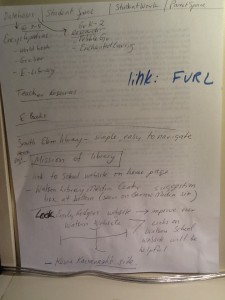In this final assignment, we were asked to create a website for a brand new school library. The more I thought about the number of hours that I would be spending on the project, and never actually using the website, the more it made sense to me to just create one for my existing library at Watson Elementary School.
Although I had created a website for my school library a few years back, it needed to be completely overhauled. So, I started over and created a website that attempts to showcase (some of) the learning I have done in this course. I must emphasize that it is very basic, more of a jumping off point, that I can add to and expand over the years as I become more comfortable with website creation tools. Here is my website: http://watsonelemlibrary.weebly.com/
I liked the clear, concise, simple design of the Smith Elementary library site, found on the list of recommended library websites that Professor Cho directed us to: http://www.mesquiteisd.org/library/smith/.
I based my design on the Smith Elementary library website, using the same navigation links across the top of the page. In my opinion, the fewer things to look at, the more I want to actually look at the page.
An example of a website that completely baffled me (too much information, opposite from the Smith website) from the recommended list was Underwood Elementary: http://uwe.leesummit.k12.mo.us/lmc/. I hardly knew where to look, there was so much print in varying fonts, colours, sizes and shapes!
My design sheet is more like a rough notes page. I knew that I wanted to have five navigational buttons across the top, so I made notes as I went to remember certain aspects I wanted to add.
My five navigational buttons across the top of my website homepage are as follows:
WELCOME – introduces the library staff, hours of operation and an important event coming up.
STUDENT RESOURCES – this is the page I spent the most amount of time on. Since my school doesn’t have an online catalogue, I wanted to acknowledge that and speak to that issue. I included a link to the Fraser Valley Regional Library, as a new branch has just opened up around the corner from my school and I have partnered with them on several projects and events. I added a link to free audio books and then at the bottom I redirected students to our Watson Elementary website, where dozens of links have been created for research, study tips, online catalogues, etc.
HOME READING – a huge program at Watson. This page includes a link at the bottom to print up more home reading sheets.
READING LINK CHALLENGE – a very popular book club that I facilitate at Watson, had to include it on the website and added a link to FVRL for more information.
BOOKS & AUTHORS – love this page, simple and fun. My goal is to eventually have students create book trailers and be able to add them to the website.
I enjoyed creating the website, and I hope you like it. Even though it is basic, it is my first attempt at adding links to open access resources, web resources, etc. I intend to add much to it over the year and hopefully it will one day become the “virtual center” of my school.
